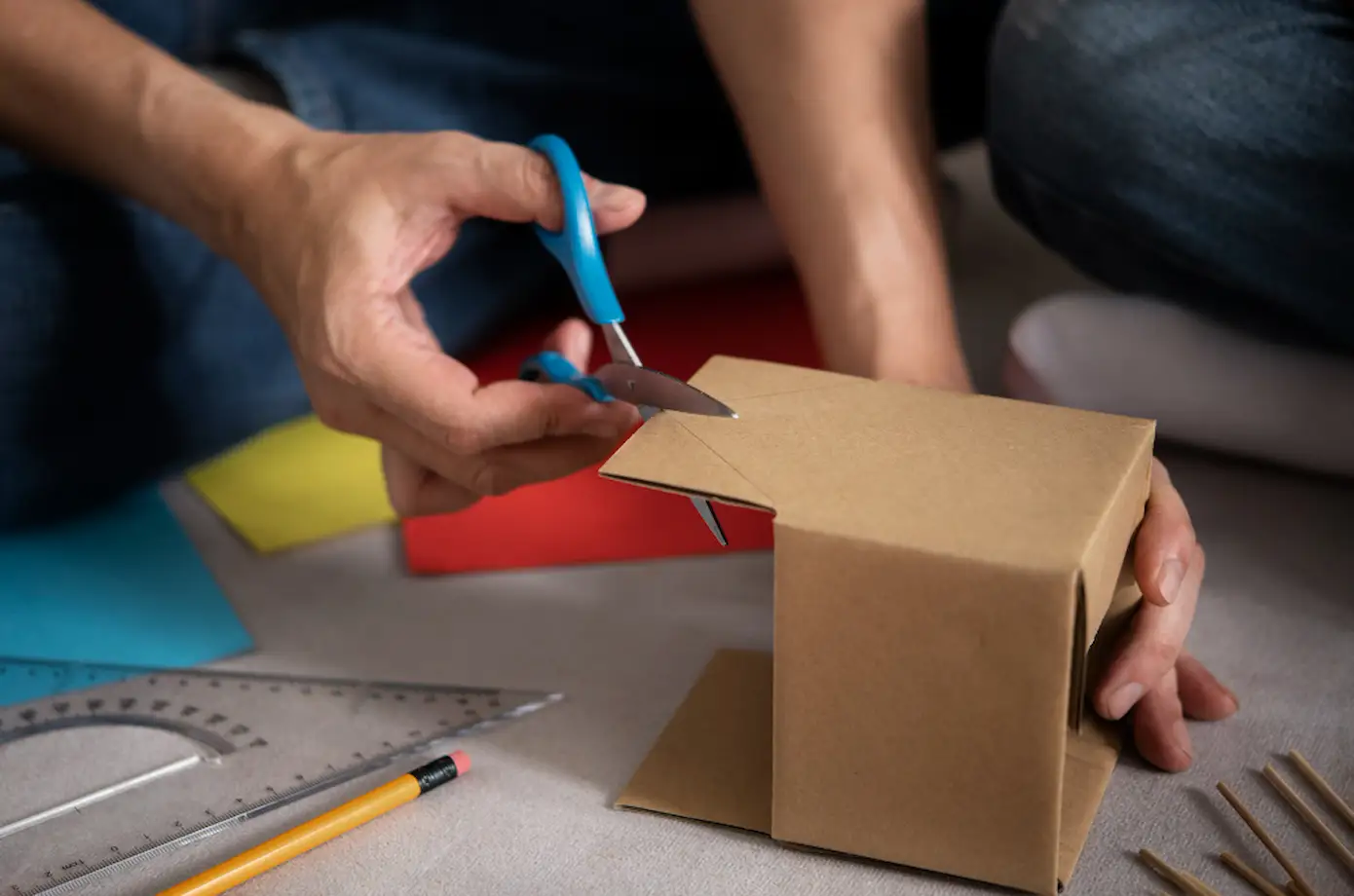How To Make a Cereal Box? 6 Easy Steps

Ever looked at an empty cereal box and thought, “Hey, I could totally make one of these myself”?
Whether you’re working on a school project, designing packaging for your own brand, or just getting crafty on a Sunday afternoon, making a cereal box is a whole lot more fun (and easier) than you might think.
With a few basic supplies and a splash of creativity, you’ll be folding, shaping, and designing like a pro in no time. Let’s roll up those sleeves and get started!
Step By Step Guide On How To Make a Cereal Box
Ready to create a cereal box that looks as good as the crunch inside? Let’s walk through it.
Nail the Basics First
Before you start folding and designing, get a grip on what makes a cereal box more than just a box. Before anything else, consider three things: material, size, and design.
- Material: You want something sturdy, sustainable, and lightweight. Think paperboard, cardboard, or kraft paper, strong enough to protect, light enough to ship without breaking the bank.
- Size: Don’t eyeball it. Measure how much cereal your box needs to hold, then match the size. From snack packs to jumbo family boxes, pick dimensions that make sense.
- Design Vibe: The cereal aisle is a visual warzone. Colors pop, mascots scream, fonts dance. Yours should too, without overdoing it. Keep it bold, clean, and brand-aligned.
Choose the Right Material
Now that you’ve got a plan, it’s time to pick your canvas.
- Paperboard: Lightweight, easy to print, and eco-friendly. Perfect for everyday cereal boxes.
- Cardboard: A tougher option for larger boxes that need a bit more muscle.
- Kraft Paper: If sustainability is your jam, kraft is king. It’s biodegradable and gives off those earthy, responsible-brand vibes.
Pro tip: Thickness matters. A thicker box keeps contents safe. A thinner one is easier (and cheaper) to ship. Find your balance.
Measure It Out & Draft Your Template
Time to roll up your sleeves. Grab a ruler, a pencil, and your chosen material. Lay it flat and sketch out your template.
Here’s a basic blueprint:
- Front and back panels
- Two side panels
- Top and bottom flaps
- Extra flaps for folding and gluing
Standard cereal box dimensions? Around 12″ tall, 7.5″ wide, and 2.5″ deep—but feel free to tweak as needed. Just remember to leave enough margin for folds and glue tabs.
Bring the Design to Life
This is where it gets fun. Fire up your favorite design tool: Canva, Illustrator, even PowerPoint if you’re feeling scrappy, and get creative. Think bold colors, sharp logos, product info, nutritional facts, and maybe even a mascot if that’s your style.
A few design must-haves:
- Brand name and product name
- Nutrition facts and ingredients
- Eye-catching visuals and consistent branding
Make sure your layout fits the template perfectly. Once it looks spot-on, print it out on high-quality paper (preferably adhesive or something easy to mount).
Cut, Score, Fold, Stick
Let’s get hands-on.
- Cut: Use scissors or a craft knife to trim out the template. Stay sharp, clean cuts mean cleaner folds.
- Score: Run a bone folder or blunt edge along the fold lines. This step helps you fold precisely without cracking the surface.
- Fold: Carefully crease each edge. Neat folds give your box a crisp, professional finish.
- Glue: Add glue or double-sided tape to the flaps. Press firmly and give it a moment to set.
- Seal: For the top, go for a tuck-in flap. Simple, effective, and the industry favorite.
Add That Final Touch
Want to give your box a little extra flair? Go ahead. Add a plastic window to show off the cereal. Try a matte finish, embossing, or even a resealable top for convenience. These little extras can make your box feel premium without going overboard.
How To Make Your Cereal Boxes More Attractive?
In a sea of colorful competition, your box needs to shout (in the right way) from the shelf. From bold visuals to smart functionality, there are plenty of ways to take your cereal box from basic to brilliant.
Always Prefer High Quality Packaging
Quality packaging isn’t just a nice-to-have, it’s a must. The right materials keep your cereal safe from moisture, air, and all the little things that try to steal its freshness.
Think sturdy paperboard, eco-friendly kraft, or classic cardboard. These options don’t just hold the product, they protect it, preserve the flavor, and keep everything crisp from shelf to spoon.
And here’s the bonus: great packaging isn’t just practical, it’s versatile. Once the cereal’s gone, the box can be repurposed in a dozen clever ways. From creative storage to DIY projects, high-quality cereal boxes stick around long after breakfast is over.
Choose Environment-Friendly Materials
Today’s consumers are reading the box itself. More than ever, people are choosing brands that care about the planet.
That’s why eco-friendly packaging isn’t just a nice gesture; it’s a business move that makes sense. Swapping out harmful materials for recyclable, biodegradable options like paperboard or kraft shows your commitment to sustainability, and customers take notice.
Using renewable materials doesn’t just reduce waste, it boosts your brand’s image. It’s a simple shift that speaks volumes about your values, helps cut down on pollution, and keeps your packaging out of landfills. So, if you’re aiming to stand out and win over the eco-conscious crowd, start with the box.
Select The Right Type of Illustrations
Let’s be real: nobody’s reaching for a boring, blank cereal box. Visuals are your secret weapon. The right illustrations don’t just decorate your packaging, they sell it. Whether it’s a playful mascot for kids or sleek, minimal graphics for health-conscious adults, your artwork should speak directly to your audience.
Custom illustrations give your brand personality. They tell a story before a single bite is taken. Think vibrant images of the cereal itself, character art, seasonal designs, or even fun facts printed on the side panels. Every inch of the box is an opportunity to engage, entertain, and inform. When done right, your illustrations don’t just grab attention, they hold it.
So, don’t hold back. Match your visuals to your audience and give your box the kind of shelf appeal that makes people stop, look, and drop it straight into their cart.
In a Nutshell
Creating the perfect cereal box is all about blending smart design with the right materials. From choosing eco-friendly packaging to adding eye-catching illustrations, every detail matters. So keep it fresh, functional, and fun. The better the box, the quicker it flies off the shelf.
FAQs
Can I make a cereal box myself?
Absolutely! You can make a cereal box yourself with just a few basic materials like paperboard or cardboard, a ruler, scissors, glue, and a bit of creativity. It’s a fun DIY project that’s perfect for school, branding mockups, or just getting crafty at home.

Jennifer James
My specialty is developing cost-effective, attractive, and appropriate packaging for protecting products. I am working with the company to design custom packaging that meets the client’s requirements.
